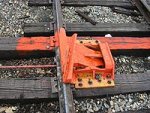When dealing with RF energy is is easy to cause the input current to mirror the carrier frequency of the transmitter thus causing havoc on electrical and electronic gear throughout a building as well the RF could be radiated from the power lines, the idea is to block the RF from leaving the building and or causing problems within the building, if this carrier is also modulated with AM it can cause feed back problems in the modulation sections ahead of the modulator so RF chokes have been use for may years to prevent this type of EMI, so it is not uncommon when dealing with HF gear to provide RF blocking on the power supply conductors as well as any other conductors that my connect to the RF gear, as I had pointed out in another thread that good designed surge protection will also include low pass chokes to not only stop HF HV transients but as a side effect they also block RF from coming in on the power supply feed, but generally the station head engineer will design and instruct as to how they want them installed and where, and may also include the company they must be purchased from if not supplied from the manufacture of the transmitter or the designer of the station, your going to need to talk with the head engineer for the station to see what they are going to require as the stations license holder is who will be responsible for designing the chokes and how they get installed.
while going for my FCC 1st class licenses at Florida Tech (which FCC did away with before I got my degree and split it between broadcast and second class which is the test I went for thinking it would have more opportunity in commercial radios) while there we did some field trips to a few radio stations, one was a shortwave station that had an ERP of 100kw, all the coils in the transmitter were water cooled as well as the RF chokes, all the power lines feeding the transmitter section run through these chokes in a room locked off from entry, the chokes stood as high as the ceiling and were huge, the coils were hollow copper tubing with water pumped through them, it was kind of amazing how big everything was.
Depending upon the frequency pass design of the chokes some will require more then one pass through the ferrite core so pay close attention to how the engineer wants them installed as well as what conductors need chokes, I would think you should have got a package of the layout and installation specs on what needs chokes and how they will be installed as this is not something that an average electrician would go through or have the knowledge to deal with without the help of the engineer, these designs are different for each transmitter as each site will present its own unique set of issues that must be designed into the transmitter system.
You stated its an FM transmitter, but that leaves allot open as to what kind of transmitter and at what power levels are we talking about, if its broadcast radio I would have assume you would already been dealing with the stations engineer, if it is some kind of a commercial transmitter or repeater then you might have to deal with the manufacture of the equipment, but follow their instructions to the letter, if this was a bid job, you might have to deal with RFI's/change orders and is one reason when getting into areas of unknowns can come back a bit you.



